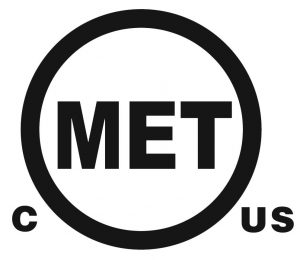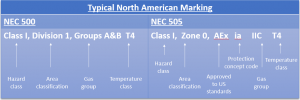The MET Mark for North America
For North America and Canada, all hazardous location (Hazloc) equipment must be assessed and approved by a NRTL (Nationally Recognised Test Laboratory) before installation. To demonstrate compliance, manufacturers can have their product assessed and tested by Eurofins CML (a MET NRTL site), and upon completion display the MET mark. The MET mark enables customers, end users, and the Authorities Having Jurisdiction (AHJ) to confidently recognise that the product has been assessed and tested by a NRTL and has been verified as compliant against the applicable standards/requirements for North America and Canada.
The process for approval is simplified below:
- The scope should be defined. This includes what Classes are required, whether the equipment is to be assessed for Divisions, Zones or both, and what protection concepts apply (please see our useful informal section below to help guide you during this stage).
- Initial assessment undertaken, including a review of the following documentation:
- Technical drawings of the product with detailed information to confirm compliance with the standards.
- Data sheets for materials/safety components
- Copies of component/equipment certificates
- Label detail
- Instructions for installation, use and maintenance.
- Existing ATEX/IECEx/North America reports (if already certified)
Where a product is already ATEX/IECEx certified some assessment may be waived, or if the North American assessment is completed alongside the ATEX/IECEx assessment the review can be combined.
- A test schedule will be arranged, specific to the protection concepts and the type of equipment being tested. Sample requirements will be explained and requested in advance.
Where a product is already ATEX/IECEx certified some testing may be waived, or if the North American testing is completed alongside ATEX/IECEx requirements, testing can be combined.
- Final assessment and technical check. This stage includes a review of any outstanding documents, or changes requested. The documentation file is then technically checked by a separate certification engineer (as is required in the certification process).
- Factory Inspections are initiated (if the manufacturer does not have a MET hazloc inspection programme in place). These consist of an initial inspection (where MET auditing is not already conducted) and 4 yearly inspections arranged. They may be done on site or remotely, and once the initial inspection is complete and the certification record is issued, manufacturers can begin to send their products out with the MET mark displayed.
- The Certification Record is issued. The certificate format includes the manufacturer name and address, product name, marking, and any specific installation requirements. The standards used to achieve certification are also listed.
As a NRTL site for MET, Eurofins CML are able to assist with all of your Hazloc testing and certification needs. Our experienced team and straight-forward approach enables manufacturers to get products tested and certified for North America, on time and on budget.
For more information on why you should choose the MET Mark and Eurofins E&E as your NRTL please follow the link below:
Please contact us for further information or assistance.
Useful Information
In North America, hazardous locations have traditionally been defined by Class and Divisions with Zones becoming adopted more recently (to align better with the approach and standards used for IECEx). In Canada all new installations must use the three Zone system. Existing installations may continue to use the two Division system or they may opt to re-classify with the three Zone system. For the US all installations (both new and existing) can continue using the two Division system or they may opt to re-classify using the three Zone approach.
The marking is made up of the following components:
| Classes: |
| Class I – A location made hazardous by the presence of flammable gases or vapours that may be present in the air in quantities sufficient to produce an explosive or ignitable mixture |
| Class II – A location made hazardous by the presence of combustible or electrically conductive dust |
| Class III – A location made hazardous by the presence of easily ignitable fibers or flyings in the air, but not likely to be in suspension in quantities sufficient to produce ignitable mixtures |
| NEC/CEC 500 – Divisions: | NEC/CEC 505 – Zones: |
| Division 1 – A location where a classified hazard exists or is likely to exist under normal conditions | Zone 0 – An area in which an explosive gas atmosphere is continuously present for a long period of time |
| Zone 1 – An area in which an explosive atmosphere is likely to occur in normal operation | |
| Division 2 – A location where a classified hazard does not normally exist but is possible to appear under abnormal conditions | Zone 2 – An area in which an explosive gas atmosphere does not normally exist |
| Dust Group Comparisons: | |||
| 2014/34/EU (ATEX) | IEC & NEC/CEC Zones | NEC/CEC (combustible dusts) | NEC/CEC (ignitable fibres & flyings) |
| IIIC | IIIC | E | n/a |
| IIIB | IIIB | F – G |
n /a |
| IIIA | IIIA | n/a | Class III |
| Gas Group Comparisons: | ||
| 2014/34/EU (ATEX) | IEC & NEC/CEC Zones | NEC/CEC Divisions |
| IIC | IIC | A / B |
| IIB | IIB | C |
| IIA | IIA | D |
| Temperature Class Comparisons (Gas & Vapours): | ||
| NEC/CEC Divisions | IEC/2014/34/EU NEC/CEC Zones | Temperature |
| T1 | T1 | ≤450°C |
| T2 | T2 | ≤300°C |
| T2A | T2 | ≤280°C |
| T2B | T2 | ≤260°C |
| T2C | T2 | ≤230°C |
| T2D | T2 | ≤215°C |
| T3 | T3 | ≤200°C |
| T3A | T3 | ≤180°C |
| T3B | T3 | ≤165°C |
| T3C | T3 | ≤160°C |
| T4 | T4 | ≤135°C |
| T4A | T4 | ≤120°C |
| T5 | T5 | ≤100°C |
| T6 | T6 | ≤85°C |
| Protection Concept Comparisons: | ||
| Europe/IEC | North American Zones | North American Divisions (not exclusive) |
| Flameproof (db) EN/IEC 60079-1 | Flameproof UL/C22.2 60079-1 | Explosion proof UL1203 / FM3615 / C22.2 No. 30 |
| Intrinsic safety (ia, ib) EN/IEC 60079-11 | Intrinsic safety UL/C22.2 60079-11 | Intrinsic safety UL913 / FM3610 / C22.2 No. 60079-11 |
| Purged + Pressurised EN/IEC 60079-2 | Purged + Pressurised UL/C22.2 60079-2 | Purged + Pressurised NFPA496 / FM3620 / ISA 12.04.01 |
| Increased safety (eb) EN/IEC 60079-7 | Increased safety UL/C22.2 60079-7 | Increased safety ISA 12.12.01 / C22.2 No. 213 |
| Encapsulation (ma, mb) EN/IEC 60079-18 | Encapsulation UL/C22.2 60079-18 | Encapsulation ISA 12.12.01 / C22.2 No. 213 |
| Powder filling (qb) EN/IEC 60079-5 | Powder fillings UL/C22.2 60079-5 | – |
| Oil filled (ob) EN/IEC 60079-6 | Oil filled UL/C22.2 60079-6 | – |
| Flameproof (dc) EN/IEC 60079-1 | Flameproof UL/C22.2 60079-1 | Enclosed break ISA 12.12.01 / C22.2 No. 213 |
| Hermetically sealed (nC) EN/IEC 60079-15 | Hermetically sealed UL/C22.2 60079-15 | Non-incendive UL 12.12.01 / C22.2 No. 213 |
| Non-incendive (nC) EN/IEC 60079-15 | Non-incendive UL/C22.2 60079-15 | Non-incendive UL 12.12.01 / C22.2 No. 213 |
| Non-sparking (nA) EN/IEC 60079-15 | Non-sparking UL/C22.2 60079-15 | Non-incendive UL 12.12.01 / C22.2 No. 213 |
| Oil filled (oc) EN/IEC 60079-6 | Oil filled UL/C22.2 60079-6 | – |
| Restricted breathing EN/IEC 60079-15 | Restricted breathing UL/C22.2 60079-15 | – |
| Optical radiation (op is) EN/IEC | Optical radiation UL/C22.2 60079-28 | – |
| Trace heating EN/IEC/IEEE 60079-30-1 | Trace heating IEC/IEEE 60079-30-1 | Trace heating IEC/IEEE (515) 60079-30-1 / C22.2 60079-30-1 |
| Process sealing EN/IEC 60079-40 | Process sealing UL/C22.2 60079-40 | – |
| Special protection (s) EN/IEC 60079-33 | – | – |
| Flame arrester EN/ISO 16852 | Flame arrester UL 525 | – |
| Diesel engines EN1834 (Part 41) | Diesel engines UL 122001 | – |
| Caplights EN/IEC 60079-35 | Caplights C22.2 60079-35 | – |
| Dust protection by enclosure EN/IEC 60079-31 | Dust protection by enclosure UL/C22.2 60079-31 | Dust protection by enclosure UL 1203/3611/3616 / ISA 12.12.01 / C22.2 No. 25 |
| Non-electrical EN/IEC 80079-36/37 | – | – |



